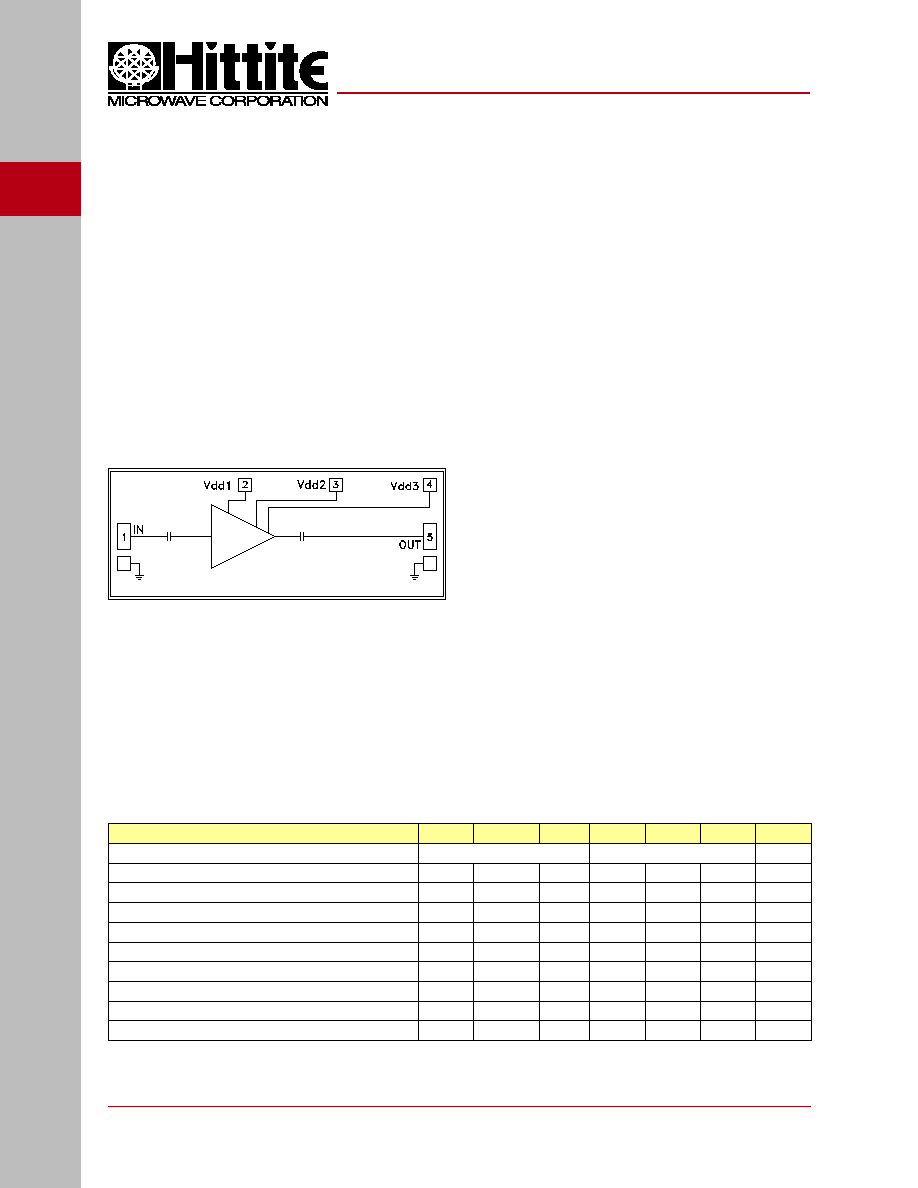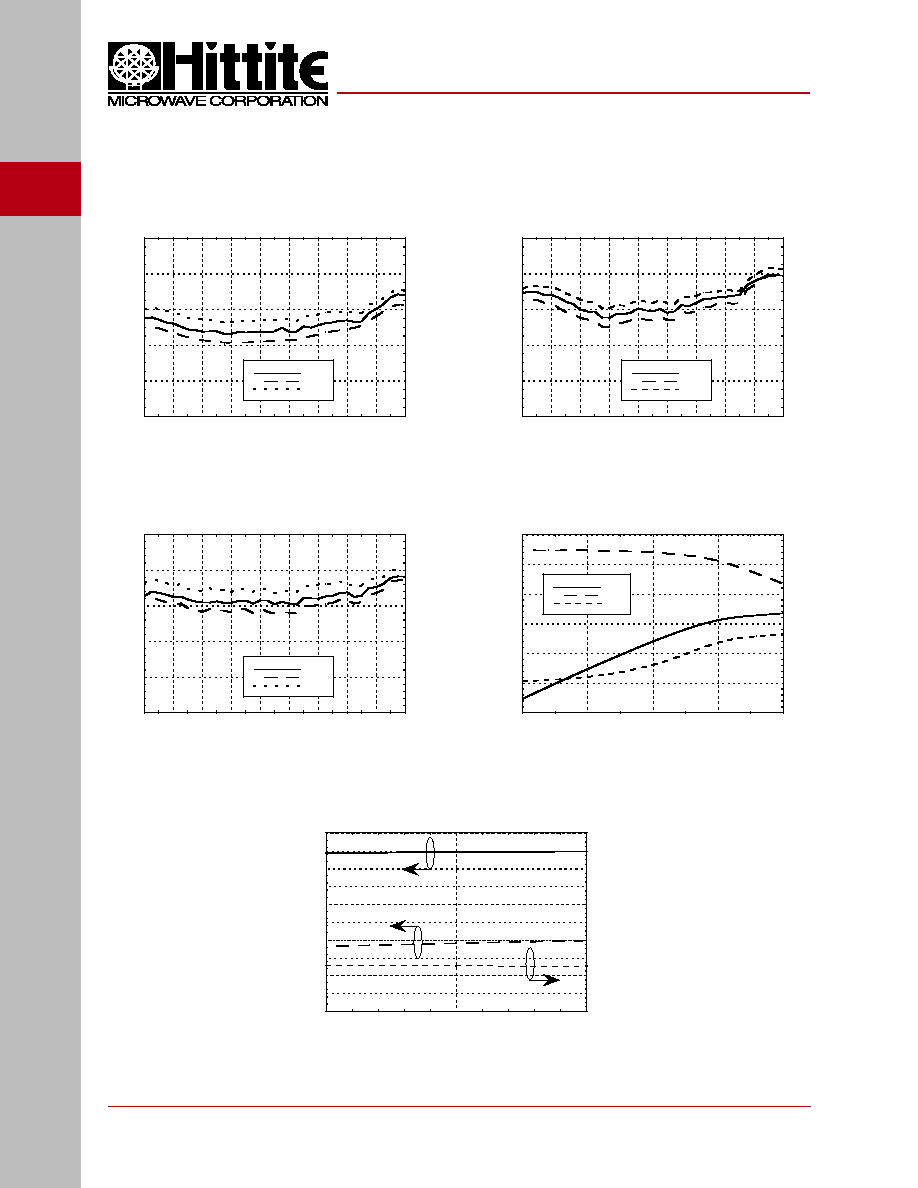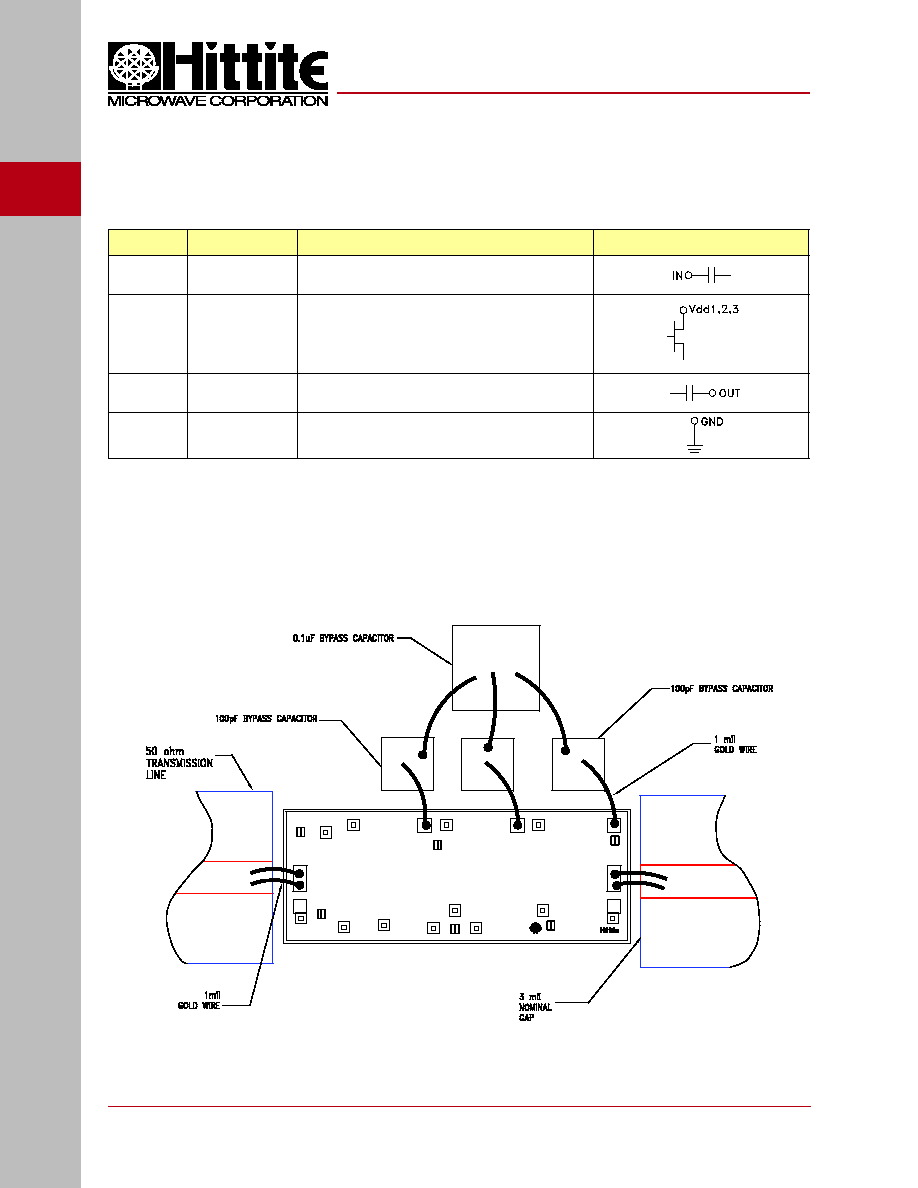 | –≠–ª–µ–∫—Ç—Ä–æ–Ω–Ω—ã–π –∫–æ–º–ø–æ–Ω–µ–Ω—Ç: HMC565 | –°–∫–∞—á–∞—Ç—å:  PDF PDF  ZIP ZIP |

A
M
P
L
IF
IE
RS
-
C
H
IP
1
1 - 210
For price, delivery, and to place orders, please contact Hittite Microwave Corporation:
20 Alpha Road, Chelmsford, MA 01824 Phone: 978-250-3343 Fax: 978-250-3373
Order On-line at www.hittite.com
HMC565
GaAs PHEMT MMIC LOW NOISE
AMPLIFIER, 6 - 20 GHz
v00.0206
General Description
Features
Functional Diagram
The HMC565 is a high dynamic range GaAs PHEMT
MMIC Low Noise Amplifi er (LNA) chip which operates
from 6 to 20 GHz. The HMC565 features 22 dB of small
signal gain, 2.3 dB of noise fi gure and has a consistent
IP3 of 20 dBm across the operating band. This self-
biased LNA is ideal for hybrid and MCM assemblies
due to its compact size, widband performance, single
+3V supply operation, and DC blocked RF I/O's.
All data is measured with the chip in a 50 Ohm test
fi xture connected via two 0.025 mm (1 mil) diameter
bondwires of minimal length 0.31 mm (12 mil).
Noise Figure: 2.3 dB
Gain: 22 dB
OIP3: 20 dBm
Single Supply: +3V @ 53 mA
50 Ohm Matched Input/Output
Small size: 2.53 x 0.98 x 0.10 mm
Electrical Specifications,
T
A
= +25∞ C, Vdd 1, 2, 3 = +3V
Typical Applications
The HMC565 is ideal for use as a LNA or driver ampli-
fi er for:
∑ Point-to-Point Radios
∑ Point-to-Multi-Point Radios & VSAT
∑ Test Equipment and Sensors
∑ Military & Space
Parameter
Min.
Typ.
Max.
Min.
Typ.
Max.
Units
Frequency Range
6 - 12
12 - 20
GHz
Gain
20
23
17
21
dB
Gain Variation Over Temperature
0.025
0.035
0.025
0.035
dB/ ∞C
Noise Figure
2.3
2.8
2.5
3.0
dB
Input Return Loss
15
12
dB
Output Return Loss
15
10
dB
Output Power for 1 dB Compression (P1dB)
7
10
7
10
dBm
Saturated Output Power (Psat)
12
12
dBm
Output Third Order Intercept (IP3)
17
20
17
20
dBm
Supply Current (Idd)(Vdd = +3V)
53
53
mA

A
M
P
L
IF
IE
RS
-
C
H
IP
1
1 - 211
For price, delivery, and to place orders, please contact Hittite Microwave Corporation:
20 Alpha Road, Chelmsford, MA 01824 Phone: 978-250-3343 Fax: 978-250-3373
Order On-line at www.hittite.com
Input Return Loss vs. Temperature
Output Return Loss vs. Temperature
Broadband Gain & Return Loss
Gain vs. Temperature
Noise Figure vs. Temperature
-30
-20
-10
0
10
20
30
4
6
8
10
12
14
16
18
20
22
S21
S11
S22
RESPONSE (dB)
FREQUENCY (GHz)
HMC565
GaAs PHEMT MMIC LOW NOISE
AMPLIFIER, 6 - 20 GHz
v00.0206
-20
-15
-10
-5
0
4
6
8
10
12
14
16
18
20
22
+25C
+85C
-55C
RETURN LOSS (dB)
FREQUENCY (GHz)
0
1
2
3
4
5
6
7
8
9
10
4
6
8
10
12
14
16
18
20
22
+25C
+85C
-55C
NOI
SE FI
GURE (dB)
FREQUENCY (GHz)
-25
-20
-15
-10
-5
0
4
6
8
10
12
14
16
18
20
22
+25C
+85C
-55C
RETURN LOSS (dB)
FREQUENCY (GHz)
0
5
10
15
20
25
30
4
6
8
10
12
14
16
18
20
22
+25C
+85C
-55C
GAIN
(dB)
FREQUENCY (GHz)
Reverse Isolation vs. Temperature
-60
-50
-40
-30
-20
-10
0
6
7
8
9
10
11
12
13
14
+25C
+85C
-55C
ISOLATION (dB)
FREQUENCY (GHz)

A
M
P
L
IF
IE
RS
-
C
H
IP
1
1 - 212
For price, delivery, and to place orders, please contact Hittite Microwave Corporation:
20 Alpha Road, Chelmsford, MA 01824 Phone: 978-250-3343 Fax: 978-250-3373
Order On-line at www.hittite.com
P1dB vs. Temperature
Power Compression @ 13 GHz
Psat vs. Temperature
Gain, Noise Figure & Power vs.
Supply Voltage @ 13 GHz
0
4
8
12
16
20
4
6
8
10
12
14
16
18
20
22
+25C
+85C
-55C
P1dB (dBm)
FREQUENCY (GHz)
v00.0206
-5
0
5
10
15
20
25
-25
-20
-15
-10
-5
Pout
Gain
PAE
Pout (dBm), GAIN (dB), PAE(%)
INPUT POWER (dBm)
0
5
10
15
20
25
0
1
2
3
4
5
6
7
8
9
10
2.5
3
3.5
GAIN (dB), P1dB (dBm)
NOI
SE FI
GURE (dB)
Vdd (Vdc)
Gain
P1dB
Noise Figure
0
4
8
12
16
20
4
6
8
10
12
14
16
18
20
22
+25C
+85C
-55C
Psat (dBm)
FREQUENCY (GHz)
Output IP3 vs. Temperature
5
10
15
20
25
30
4
6
8
10
12
14
16
18
20
22
+25C
+85C
-55C
OIP3 (dBm)
FREQUENCY (GHz)
HMC565
GaAs PHEMT MMIC LOW NOISE
AMPLIFIER, 6 - 20 GHz

A
M
P
L
IF
IE
RS
-
C
H
IP
1
1 - 213
For price, delivery, and to place orders, please contact Hittite Microwave Corporation:
20 Alpha Road, Chelmsford, MA 01824 Phone: 978-250-3343 Fax: 978-250-3373
Order On-line at www.hittite.com
Outline Drawing
Absolute Maximum Ratings
Drain Bias Voltage (Vdd1, Vdd2, Vdd3)
+3.5 Vdc
RF Input Power (RFin)(Vdd = +3.0 Vdc)
0 dBm
Channel Temperature
175 ∞C
Continuous Pdiss (T= 85 ∞C)
(derate 8.9 mW/∞C above 85 ∞C)
0.75 W
Thermal Resistance
(channel to die bottom)
119 ∞C/W
Storage Temperature
-65 to +150 ∞C
Operating Temperature
-55 to +85 ∞C
Vdd (Vdc)
Idd (mA)
+2.5
51
+3.0
53
+3.5
55
Typical Supply Current vs. Vdd
Note: Amplifier will operate over full voltage ranges shown
above.
NOTES:
1. ALL DIMENSIONS ARE IN INCHES [MM]
2. DIE THICKNESS IS .004"
3. TYPICAL BOND IS .004" SQUARE
4. BACKSIDE METALLIZATION: GOLD
5. BOND PAD METALLIZATION: GOLD
6. BACKSIDE METAL IS GROUND.
7. CONNECTION NOT REQUIRED FOR UNLABELED BOND PADS.
ELECTROSTATIC SENSITIVE DEVICE
OBSERVE HANDLING PRECAUTIONS
Die Packaging Information
[1]
Standard
Alternate
GP-2
[2]
[1] Refer to the "Packaging Information" section for die
packaging dimensions.
[2] For alternate packaging information contact Hittite
Microwave Corporation.
v00.0206
HMC565
GaAs PHEMT MMIC LOW NOISE
AMPLIFIER, 6 - 20 GHz

A
M
P
L
IF
IE
RS
-
C
H
IP
1
1 - 214
For price, delivery, and to place orders, please contact Hittite Microwave Corporation:
20 Alpha Road, Chelmsford, MA 01824 Phone: 978-250-3343 Fax: 978-250-3373
Order On-line at www.hittite.com
Pad Descriptions
Pad Number
Function
Description
Interface Schematic
1
IN
This pad is AC coupled and matched to
50 Ohms from 6 - 20 GHz.
2, 3, 4
Vdd1, 2, 3
Power Supply Voltage for the amplifi er. External bypass
capacitors of 100 pF and 0.1 F are required.
5
OUT
This pad is AC coupled and matched to
50 Ohms from 6 - 20 GHz.
Die Bottom
GND
Die Bottom must be connected to RF/DC ground.
Assembly Diagram
v00.0206
HMC565
GaAs PHEMT MMIC LOW NOISE
AMPLIFIER, 6 - 20 GHz

A
M
P
L
IF
IE
RS
-
C
H
IP
1
1 - 215
For price, delivery, and to place orders, please contact Hittite Microwave Corporation:
20 Alpha Road, Chelmsford, MA 01824 Phone: 978-250-3343 Fax: 978-250-3373
Order On-line at www.hittite.com
Mounting & Bonding Techniques for Millimeterwave GaAs MMICs
The die should be attached directly to the ground plane eutectically or with
conductive epoxy (see HMC general Handling, Mounting, Bonding Note).
50 Ohm Microstrip transmission lines on 0.127mm (5 mil) thick alumina thin fi lm
substrates are recommended for bringing RF to and from the chip (Figure 1). If
0.254mm (10 mil) thick alumina thin fi lm substrates must be used, the die should be
raised 0.150mm (6 mils) so that the surface of the die is coplanar with the surface
of the substrate. One way to accomplish this is to attach the 0.102mm (4 mil) thick
die to a 0.150mm (6 mil) thick molybdenum heat spreader (moly-tab) which is then
attached to the ground plane (Figure 2).
Microstrip substrates should be brought as close to the die as possible in order to
minimize bond wire length. Typical die-to-substrate spacing is 0.076mm (3 mils).
Handling Precautions
Follow these precautions to avoid permanent damage.
Storage: All bare die are placed in either Waffl e or Gel based ESD protective
containers, and then sealed in an ESD protective bag for shipment. Once the
sealed ESD protective bag has been opened, all die should be stored in a dry
nitrogen environment.
Cleanliness: Handle the chips in a clean environment. DO NOT attempt to clean
the chip using liquid cleaning systems.
Static Sensitivity: Follow ESD precautions to protect against > ± 250V ESD
strikes.
Transients: Suppress instrument and bias supply transients while bias is applied.
Use shielded signal and bias cables to minimize inductive pick-up.
General Handling: Handle the chip along the edges with a vacuum collet or with
a sharp pair of bent tweezers. The surface of the chip has fragile air bridges and
should not be touched with vacuum collet, tweezers, or fi ngers.
Mounting
The chip is back-metallized and can be die mounted with AuSn eutectic preforms
or with electrically conductive epoxy. The mounting surface should be clean and
fl at.
Eutectic Die Attach: A 80/20 gold tin preform is recommended with a work surface temperature of 255 ∞C and a tool temperature
of 265 ∞C. When hot 90/10 nitrogen/hydrogen gas is applied, tool tip temperature should be 290 ∞C. DO NOT expose the chip
to a temperature greater than 320 ∞C for more than 20 seconds. No more than 3 seconds of scrubbing should be required for
attachment.
Epoxy Die Attach: Apply a minimum amount of epoxy to the mounting surface so that a thin epoxy fi llet is observed around the
perimeter of the chip once it is placed into position. Cure epoxy per the manufacturer's schedule.
Wire Bonding
Ball or wedge bond with 0.025 mm (1 mil) diameter pure gold wire is recommended. Thermosonic wirebonding with a nominal stage
temperature of 150 ∞C and a ball bonding force of 40 to 50 grams or wedge bonding force of 18 to 22 grams is recommended. Use
the minimum level of ultrasonic energy to achieve reliable wirebonds. Wirebonds should be started on the chip and terminated on
the package or substrate. All bonds should be as short as possible <0.31 mm (12 mils).
0.102mm (0.004") Thick GaAs MMIC
Wire Bond
RF Ground Plane
0.127mm (0.005") Thick Alumina
Thin Film Substrate
0.076mm
(0.003")
Figure 1.
0.102mm (0.004") Thick GaAs MMIC
Wire Bond
RF Ground Plane
0.254mm (0.010") Thick Alumina
Thin Film Substrate
0.076mm
(0.003")
Figure 2.
0.150mm (0.005") Thick
Moly Tab
v00.0206
HMC565
GaAs PHEMT MMIC LOW NOISE
AMPLIFIER, 6 - 20 GHz





